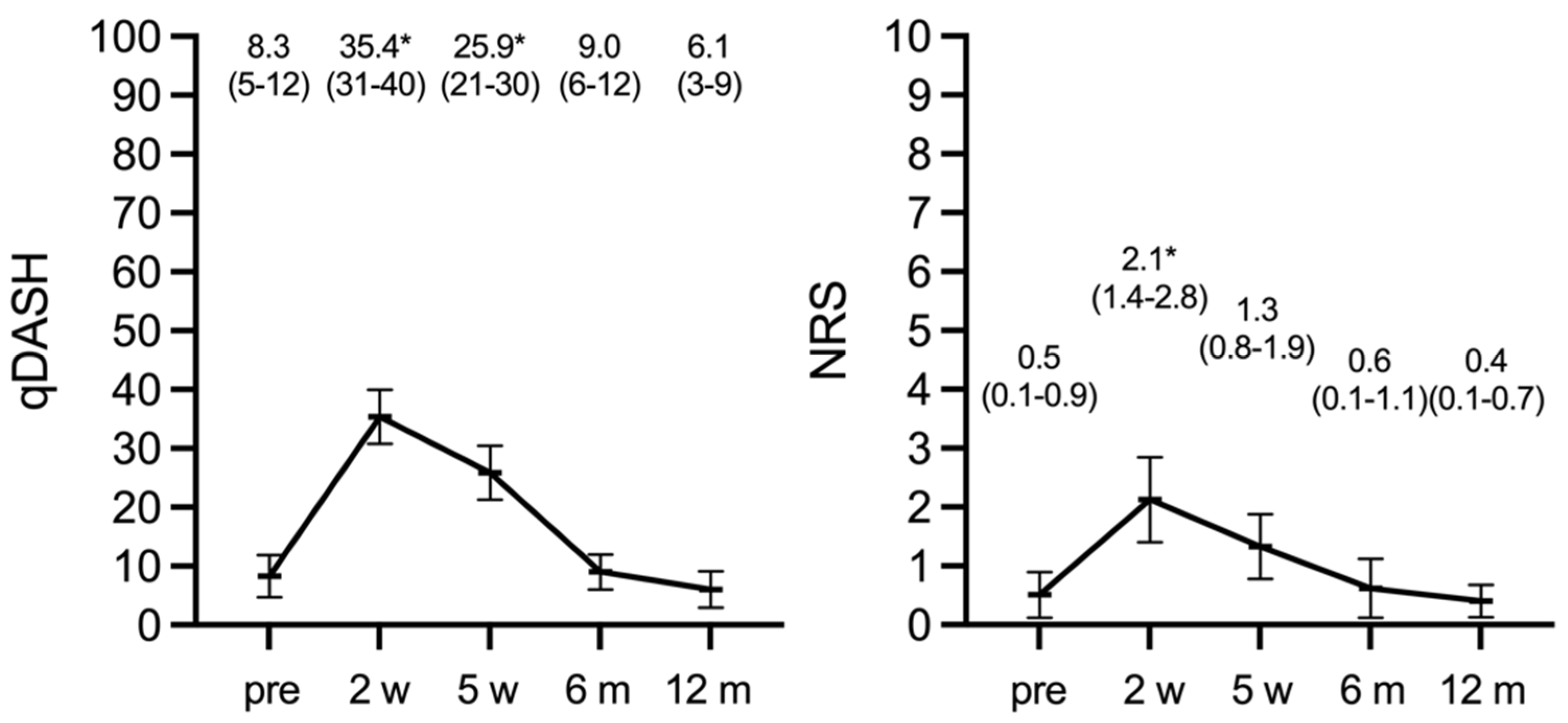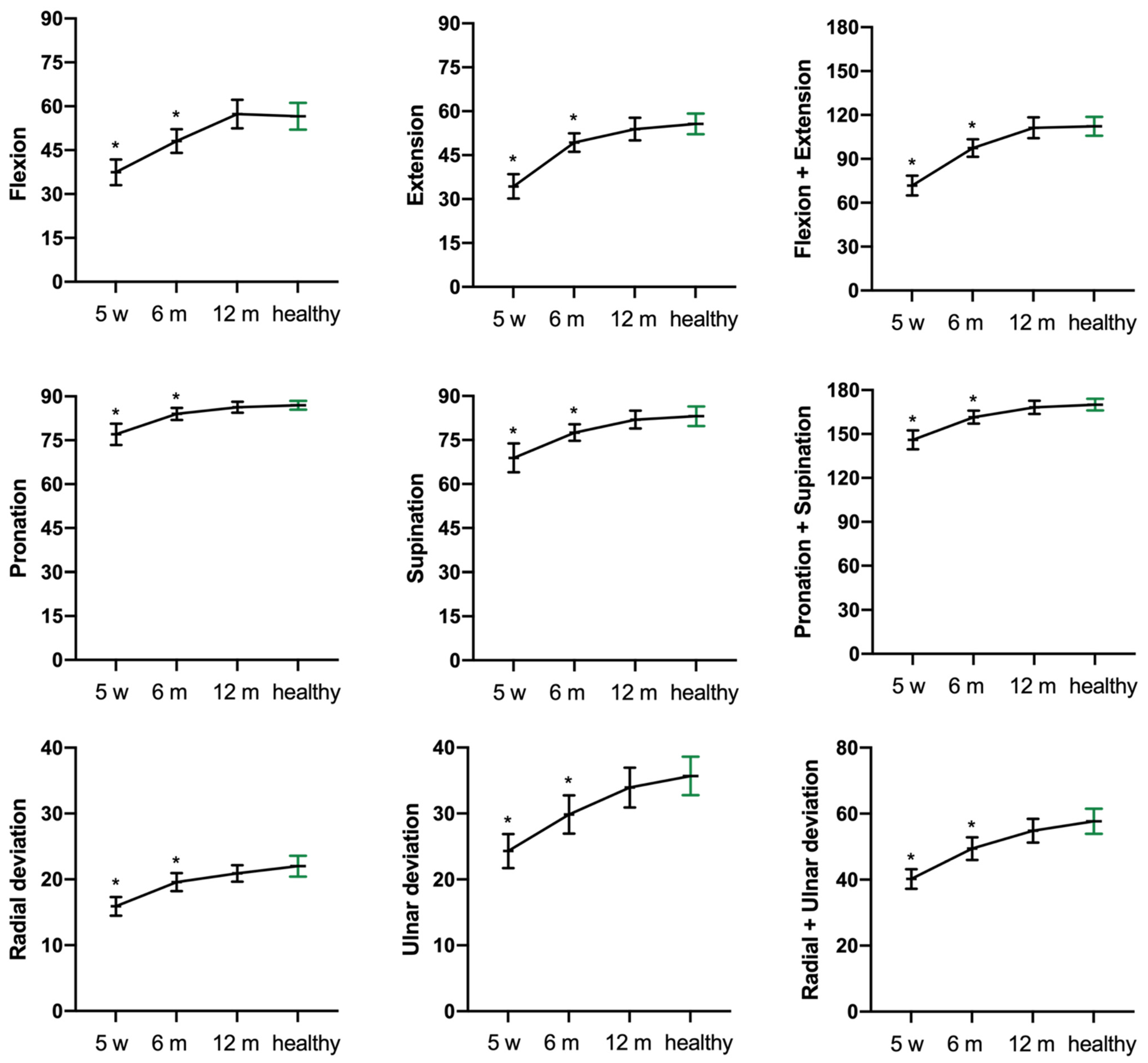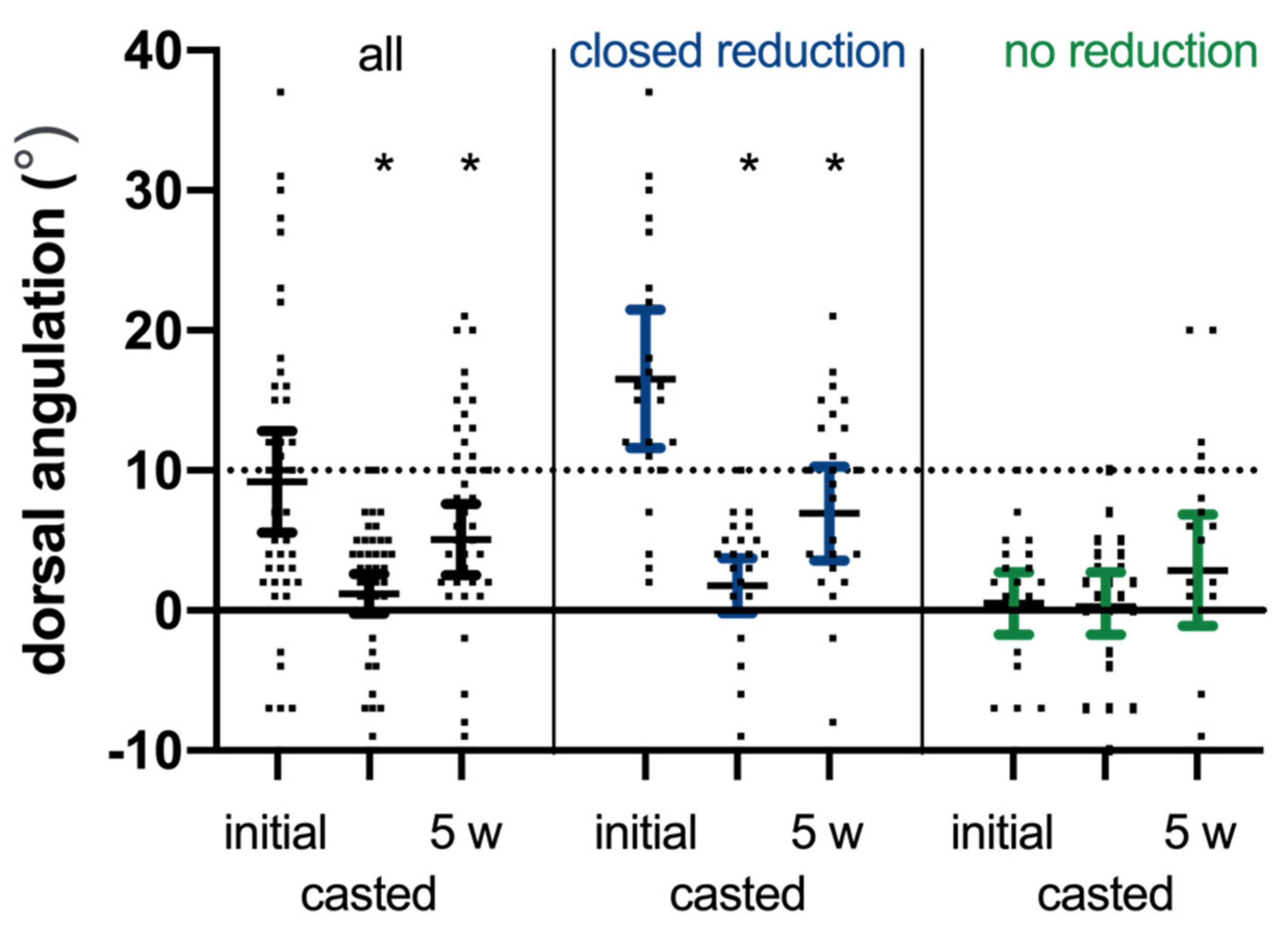Objective Outcome Measures Continue to Improve from 6 to 12 Months after Conservatively Treated Distal Radius Fractures in the Elderly—A Prospective Evaluation of 50 Patients
Abstract
1. Introduction
- >10° dorsal angulation of the radial joint surface;
- >2 mm articular step-off;
- >2 mm ulnar variance;
- Incongruence of the distal radioulnar joint;
- Substantial dorsal comminution indicating cross instability.
2. Materials and Methods
2.1. Study Design
2.2. Recruitment
2.3. Interventions
2.3.1. Primary Outcomes
- -
- Sensory disturbance including carpal tunnel syndrome and chronic regional pain syndrome (CRPS);
- -
- Flexor tendon rupture and irritation;
- -
- Extensor tendon rupture and irritation;
- -
- Infection: superficial or deep;
- -
- Hardware failure and hardware loosening;
- -
- Reoperation including hardware removal or replacement.
2.3.2. Secondary Outcomes
2.4. Data Management and Statistical Analysis
3. Results
3.1. Primary Outcome Measure: Complications
3.2. Secondary Outcome Measures: Patient-Related Outcome Measures (qDASH and Their Correlation to PRWHE) and Pain Score (NRS)
3.3. Grip Strength
3.4. Quality of Life (EQ5D)
3.5. Dorsal Angulation
4. Discussion
Strengths and Limitations
5. Conclusions
Author Contributions
Funding
Institutional Review Board Statement
Informed Consent Statement
Data Availability Statement
Conflicts of Interest
References
- Baron, J.A.; Karagas, M.; Barrett, J.; Kniffin, W.; Malenka, D.; Mayor, M.; Keller, R.B. Basic Epidemiology of Fractures of the Upper and Lower Limb among Americans over 65 Years of Age. Epidemiology 1996, 7, 612–618. [Google Scholar] [CrossRef]
- Christensen, M.; Troelsen, A.; Kold, S.; Brix, M.; Ban, I. Treatment of distal radius fractures in the elderly. Ugeskr. Laeger 2015, 177, V11140614. [Google Scholar]
- Nellans, K.W.; Kowalski, E.; Chung, K.C. The Epidemiology of Distal Radius Fractures. Hand Clin. 2012, 28, 113–125. [Google Scholar] [CrossRef] [PubMed]
- Sundhedsstyrelsen. Nationale Kliniske Retningslinjer for Behandling af Håndledsnære Brud; Sundhedsstyrelsen: Copenhagen, Denmark, 2014. [Google Scholar]
- Madsen, M.L.; Wæver, D.; Borris, L.C.; Nagel, L.L.; Henriksen, M.; Thorninger, R.; Rölfing, J.D. Volar plating of distal radius fractures does not restore the anatomy. Dan. Med. J. 2018, 65, A5497. [Google Scholar]
- Johnson, N.; Leighton, P.; Pailthorpe, C.; Dias, J.; Distal Radius Fracture Delphi Study Group. Defining displacement thresholds for surgical intervention for distal radius fractures—A Delphi study. PLoS ONE 2019, 14, e0210462. [Google Scholar] [CrossRef]
- Ng, C.Y.; McQueen, M.M. What are the radiological predictors of functional outcome following fractures of the distal radius? J. Bone Jt. Surgery. Br. Vol. 2011, 93, 145–150. [Google Scholar] [CrossRef]
- Thorninger, R.; Madsen, M.L.; Wæver, D.; Borris, L.C.; Rölfing, J.H.D. Complications of volar locking plating of distal radius fractures in 576 patients with 3.2 years follow-up. Injury 2017, 48, 1104–1109. [Google Scholar] [CrossRef] [PubMed]
- Pedersen, J.; Mortensen, S.O.; Rölfing, J.D.; Thorninger, R. A protocol for a single-center, single-blinded randomized-controlled trial investigating volar plating versus conservative treatment of unstable distal radius fractures in patients older than 65 years. BMC Musculoskelet. Disord. 2019, 20, 1–10. [Google Scholar] [CrossRef] [PubMed]
- Schønnemann, J.O.; Eggers, J. Validation of the Danish version of the Quick-Disabilities of Arm, Shoulder and Hand Questionnaire. Dan. Med. J. 2016, 63, A5306. [Google Scholar] [PubMed]
- London, D.A.; Stepan, J.G.; Boyer, M.I.; Calfee, R.P. Performance Characteristics of the Verbal QuickDASH. J. Hand Surg. 2014, 39, 100–107. [Google Scholar] [CrossRef]
- Goldhahn, J.; Beaton, D.; Ladd, A.; MacDermid, J.; Hoang-Kim, A. Recommendation for measuring clinical outcome in distal radius fractures: A core set of domains for standardized reporting in clinical practice and research. Arch. Orthop. Trauma Surg. 2014, 134, 197–205. [Google Scholar] [CrossRef]
- Franchignoni, F.; Vercelli, S.; Giordano, A.; Sartorio, F.; Bravini, E.; Ferriero, G. Minimal Clinically Important Difference of the Disabilities of the Arm, Shoulder and Hand Outcome Measure (DASH) and Its Shortened Version (QuickDASH). J. Orthop. Sports Phys. Ther. 2014, 44, 30–39. [Google Scholar] [CrossRef] [PubMed]
- The DASH Outcome Measure—Disabilities of the Arm, Shoulder, and Hand. Available online: https://www.dash.iwh.on.ca/faq (accessed on 26 June 2019).
- Saving, J.; Wahlgren, S.S.; Olsson, K.; Enocson, A.; Ponzer, S.; Sköldenberg, O.; Wilcke, M.; Navarro, C.M. Nonoperative Treatment Compared with Volar Locking Plate Fixation for Dorsally Displaced Distal Radial Fractures in the Elderly: A Randomized Controlled Trial. J. Bone Jt. Surg. Am. 2019, 101, 961–969. [Google Scholar] [CrossRef] [PubMed]
- Hamilton, G.F.; McDonald, C.; Chenier, T.C. Measurement of Grip Strength: Validity and Reliability of the Sphygmomanometer and Jamar Grip Dynamometer. J. Orthop. Sports Phys. Ther. 1992, 16, 215–219. [Google Scholar] [CrossRef]
- Kim, J.K.; Park, M.G.; Shin, S.J. What is the Minimum Clinically Important Difference in Grip Strength? Clin. Orthop. Relat. Res. 2014, 472, 2536–2541. [Google Scholar] [CrossRef] [PubMed]
- Rabin, R.; de Charro, F. EQ-5D: A measure of health status from the EuroQol Group. Ann. Med. 2001, 33, 337–343. [Google Scholar] [CrossRef] [PubMed]
- Hansen, A.Ø.; Knygsand-Roenhoej, K.; Ardensø, K. Danish version of the Patient-Rated Wrist/Hand Evaluation questionnaire: Translation, cross-cultural adaptation, test–retest reliability and construct validity. Hand Ther. 2018, 24, 22–30. [Google Scholar] [CrossRef]
- Harris, P.A.; Taylor, R.; Thielke, R.; Payne, J.; Gonzalez, N.; Conde, J.G. Research electronic data capture (REDCap)—A metadata-driven methodology and workflow process for providing translational research informatics support. J. Biomed. Inform. 2009, 42, 377–381. [Google Scholar] [CrossRef] [PubMed]
- Hove, L.M. Delayed rupture of the thumb extensor tendon: A 5-year study of 18 consecutive cases. Acta Orthop. Scand. 1994, 65, 199–203. [Google Scholar] [CrossRef]
- Aparicio, P.; Izquierdo, Ó.; Castellanos, J. Conservative Treatment of Distal Radius Fractures: A Prospective Descriptive Study. HAND 2018, 13, 448–454. [Google Scholar] [CrossRef]
- Dewan, N.; MacDermid, J.C.; Grewal, R.; Beattie, K. Recovery patterns over 4 years after distal radius fracture: Descriptive changes in fracture-specific pain/disability, fall risk factors, bone mineral density, and general health status. J. Hand Ther. 2018, 31, 451–464. [Google Scholar] [CrossRef] [PubMed]
- Tsang, P.; Walton, D.; Grewal, R.; MacDermid, J. Validation of the QuickDASH and DASH in Patients With Distal Radius Fractures Through Agreement Analysis. Arch. Phys. Med. Rehabil. 2017, 98, 1217–1222.e1. [Google Scholar] [CrossRef] [PubMed]
- Angst, F.; Goldhahn, J.; Drerup, S.; Flury, M.; Schwyzer, H.-K.; Simmen, B.R. How sharp is the short QuickDASH? A refined content and validity analysis of the short form of the disabilities of the shoulder, arm and hand questionnaire in the strata of symptoms and function and specific joint conditions. Qual. Life Res. 2009, 18, 1043–1051. [Google Scholar] [CrossRef] [PubMed]
- Hassellund, S.S.; Williksen, J.H.; Laane, M.M.; Pripp, A.; Rosales, C.P.; Karlsen, Ø.; Madsen, J.E.; Frihagen, F. Cast immobilization is non-inferior to volar locking plates in relation to QuickDASH after one year in patients aged 65 years and older: A randomized controlled trial of displaced distal radius fractures. Bone Jt. J. 2021, 103, 247–255. [Google Scholar] [CrossRef] [PubMed]
- Ramesh, S.; Sd, R.; Rao, C. Nonoperative treatment compared with volar locking plate fixation for displaced and unstable distal radius fractures in patients sixty-five years of age and older—A prospective randomized trial. Int. J. Orthop. Sci. 2020, 6, 728–733. [Google Scholar] [CrossRef]
- Arora, R.; Lutz, M.; Deml, C.; Krappinger, D.; Haug, L.; Gabl, M. A Prospective Randomized Trial Comparing Nonoperative Treatment with Volar Locking Plate Fixation for Displaced and Unstable Distal Radial Fractures in Patients Sixty-five Years of Age and Older. J. Bone Jt. Surg. Am. Vol. 2011, 93, 2146–2153. [Google Scholar] [CrossRef]
- Bartl, C.; Stengel, D.; Bruckner, T.; Gebhard, F. The Treatment of Displaced Intra-articular Distal Radius Fractures in Elderly Patients. Dtsch. Aerzteblatt Online 2014, 111, 779–787. [Google Scholar] [CrossRef]
- Hevonkorpi, T.P.; The NITEP-Group; Launonen, A.P.; Raittio, L.; Luokkala, T.; Kukkonen, J.; Reito, A.; Sumrein, B.O.; Laitinen, M.K.; Mattila, V.M. Nordic Innovative Trial to Evaluate OsteoPorotic Fractures (NITEP-group): Non-operative treatment versus surgery with volar locking plate in the treatment of distal radius fracture in patients aged 65 and over—a study protocol for a prospective, randomized controlled trial. BMC Musculoskelet. Disord. 2018, 19, 1–9. [Google Scholar]
- Martinez-Mendez, D.; Lizaur-Utrilla, A.; De-Juan-Herrero, J. Intra-articular distal radius fractures in elderly patients: A randomized prospective study of casting versus volar plating. J. Hand Surg. Eur. Vol. 2018, 43, 142–147. [Google Scholar] [CrossRef]
- Calfee, R.P. CORR Insights®: What is the Relative Effectiveness of the Various Surgical Treatment Options for Distal Radius Fractures? A Systematic Review and Network Meta-analysis of Randomized Controlled Trials. Clin. Orthop. Relat. Res. 2021, 479, 363–365. [Google Scholar] [CrossRef]
- Li, Q.; Ke, C.; Han, S.; Xu, X.; Cong, Y.-X.; Shang, K.; Liang, J.-D.; Zhang, B.-F. Nonoperative treatment versus volar locking plate fixation for elderly patients with distal radial fracture: A systematic review and meta-analysis. J. Orthop. Surg. Res. 2020, 15, 1–9. [Google Scholar]
- Stephens, A.R.; Presson, A.P.; McFarland, M.M.; Zhang, C.; Sirniö, K.; Mulders, M.A.; Schep, N.W.; Tyser, A.R.; Kazmers, N.H. Volar Locked Plating Versus Closed Reduction and Casting for Acute, Displaced Distal Radial Fractures in the Elderly: A Systematic Review and Meta-Analysis of Randomized Controlled Trials. J. Bone Jt. Surg. Am. 2020, 102, 1280–1288. [Google Scholar] [CrossRef] [PubMed]
- Woolnough, T.; Axelrod, D.; Bozzo, A.; Koziarz, A.; Koziarz, F.; Oitment, C.; Gyemi, L.; Gormley, J.; Gouveia, K.; Johal, H. What Is the Relative Effectiveness of the Various Surgical Treatment Options for Distal Radius Fractures? A Systematic Review and Network Meta-analysis of Randomized Controlled Trials. Clin. Orthop. Relat. Res. 2021, 479, 348–362. [Google Scholar] [CrossRef] [PubMed]
- Lawson, A.; Naylor, J.M.; Buchbinder, R.; Ivers, R.; Balogh, Z.J.; Smith, P.; Xuan, P.; Howard, K.; Vafa, A.; Perriman, D.; et al. Surgical Plating vs Closed Reduction for Fractures in the Distal Radius in Older Patients: A Randomized Clinical Trial. JAMA Surg. 2021, 156, 229–237. [Google Scholar]




| n (%) | ||
|---|---|---|
| Sex | Female | 41 (82) |
| Male | 9 (18) | |
| Age (years) | Median age | 73.5 |
| Range | 65–100 | |
| IQR | 70–78 | |
| Fractured side | Right | 18 (36) |
| Left | 32 (64) | |
| Hand dominance | Right | 43 (86) |
| Left | 4 (8) | |
| Ambidextrous | 3 (6) | |
| Dominant side fractured * | 20 (40) | |
| Working status | Full-time/part-time work | 0 (0) |
| Volunteer work | 3 (6) | |
| Retired | 47 (94) | |
| Smoking status | Non-smoker | 41 (82) |
| Smoker | 9 (18) | |
| Alcohol consumption ** | <7/14 units/week | 44 (88) |
| >7/14 units/week | 6 (12) | |
| ASA class | ASA class 1 | 16 (32) |
| ASA class 2 | 25 (50) | |
| ASA class 3 | 9 (18) | |
| ASA class 4–5 | 0 (0) | |
| Comorbidities | Osteoporosis | 7 (14) |
| Diabetes | 3 (6) | |
| Hypertension | 22 (44) | |
| Depression | 9 (18) | |
| Medications | No medications | 5 (10) |
| 1–4 medications | 38 (76) | |
| ≥5 medications (polypharmacy) | 7 (14) |
| Complications | Day 0 (n = 50) | 2 Weeks (n = 50) | 5 Weeks (n = 50) | 6 Months (n = 50) | 12 Months (n = 48) |
|---|---|---|---|---|---|
| Sensory disturbance | 1 | 1 | 0 | 6 (12%) * | 2 |
| Flexor tendon rupture and irritation | 0 | 0 | 0 | 0 | 0 |
| Extensor tendon rupture and irritation | 0 | 0 | 0 | 0 | 0 |
| Vascular compromised (capillary refill ≥ 2 s) | 0 | 0 | 0 | 0 | 0 |
| Other | 0 | 2 ** | 0 | 2 (4%) *** | 1 **** |
| Total: | 1 | 3 | 0 | 8 (16%) | 3 |
| Parameter | 6 Months | 12 Months |
|---|---|---|
| Mobility: | ||
| Level 1 | 45 (90%) | 39 (81%) |
| Level 2 | 5 (10%) | 9 (19%) |
| Level 3 | 0 (0%) | 0 (0%) |
| Total | 50 (100%) | 48 (100%) |
| Self-care: | ||
| Level 1 | 45 (90%) | 46 (96%) |
| Level 2 | 5 (10%) | 2 (4%) |
| Level 3 | 0 (0%) | 0 (0%) |
| Total | 50 (100%) | 48 (100%) |
| Usual activities: | ||
| Level 1 | 43 (86%) | 44 (92%) |
| Level 2 | 6 (12%) | 4 (8%) |
| Level 3 | 1 (2%) | 0 (0%) |
| Total | 50 (100%) | 48 (100%) |
| Pain/discomfort: | ||
| Level 1 | 24 (48%) | 39 (81%) |
| Level 2 | 26 (52%) | 9 (19%) |
| Level 3 | 0 (0%) | 0 (0%) |
| Total | 50 (100%) | 48 (100%) |
| Anxiety/depression: | ||
| Level 1 | 46 (92%) | 45 (94%) |
| Level 2 | 4 (8%) | 3 (6%) |
| Level 3 | 0 (0%) | 0 (0%) |
| Total | 50 (100%) | 48 (100%) |
Publisher’s Note: MDPI stays neutral with regard to jurisdictional claims in published maps and institutional affiliations. |
© 2021 by the authors. Licensee MDPI, Basel, Switzerland. This article is an open access article distributed under the terms and conditions of the Creative Commons Attribution (CC BY) license (https://creativecommons.org/licenses/by/4.0/).
Share and Cite
Thorninger, R.; Wæver, D.; Pedersen, J.; Tvedegaard-Christensen, J.; Tjørnild, M.; Lind, M.; Rölfing, J.D. Objective Outcome Measures Continue to Improve from 6 to 12 Months after Conservatively Treated Distal Radius Fractures in the Elderly—A Prospective Evaluation of 50 Patients. J. Clin. Med. 2021, 10, 1831. https://doi.org/10.3390/jcm10091831
Thorninger R, Wæver D, Pedersen J, Tvedegaard-Christensen J, Tjørnild M, Lind M, Rölfing JD. Objective Outcome Measures Continue to Improve from 6 to 12 Months after Conservatively Treated Distal Radius Fractures in the Elderly—A Prospective Evaluation of 50 Patients. Journal of Clinical Medicine. 2021; 10(9):1831. https://doi.org/10.3390/jcm10091831
Chicago/Turabian StyleThorninger, Rikke, Daniel Wæver, Jonas Pedersen, Jens Tvedegaard-Christensen, Michael Tjørnild, Martin Lind, and Jan Duedal Rölfing. 2021. "Objective Outcome Measures Continue to Improve from 6 to 12 Months after Conservatively Treated Distal Radius Fractures in the Elderly—A Prospective Evaluation of 50 Patients" Journal of Clinical Medicine 10, no. 9: 1831. https://doi.org/10.3390/jcm10091831
APA StyleThorninger, R., Wæver, D., Pedersen, J., Tvedegaard-Christensen, J., Tjørnild, M., Lind, M., & Rölfing, J. D. (2021). Objective Outcome Measures Continue to Improve from 6 to 12 Months after Conservatively Treated Distal Radius Fractures in the Elderly—A Prospective Evaluation of 50 Patients. Journal of Clinical Medicine, 10(9), 1831. https://doi.org/10.3390/jcm10091831






